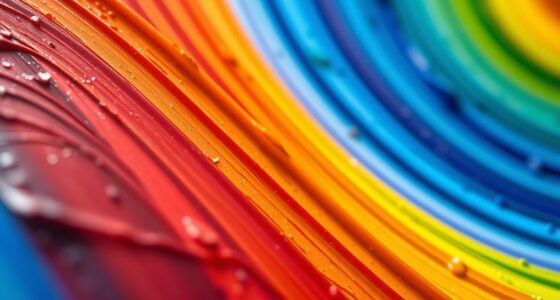Colors can influence your decision-making by triggering subconscious emotional responses and shaping your perceptions without you even realizing it. Bright reds might make you act quickly or feel excited, while calming blues can build trust. These effects are used by brands to guide your choices subtly. Understanding how colors work can help you become more aware of these hidden cues. If you keep exploring, you’ll discover even more about how color impacts your everyday decisions.
Key Takeaways
- Colors evoke subconscious emotional responses that influence perceptions and decision-making without conscious awareness.
- Specific colors like red and blue are strategically used to trigger feelings of urgency or trust, affecting choices.
- Visual cues, including color, establish immediate impressions that can sway consumer preferences and behaviors.
- Awareness of color psychology helps individuals recognize and understand the subconscious factors behind their decisions.
- Incorporating understanding of color influence can enhance marketing strategies and personal decision-making.

Colors have a powerful influence on our decision-making processes, often shaping our perceptions and choices without us even realizing it. When you see a vibrant red logo or a calm blue background, your emotional responses are immediately affected, subtly guiding how you feel about a brand. This emotional reaction isn’t accidental; designers and marketers carefully select colors to evoke specific feelings that align with their brand message. For example, red can create excitement or urgency, making you more likely to act quickly, while blue often conveys trust and reliability, encouraging you to feel more confident in a brand’s credibility. These emotional responses influence your perception of the brand, shaping how you view its quality, dependability, or appeal. Over time, these perceptions become deeply ingrained, affecting your future choices without you even realizing it.
As you encounter different colors in various contexts—whether shopping online, walking through a store, or browsing advertisements—you may find yourself drawn to certain products or brands simply because of their color scheme. That’s because colors help establish a mental connection, forming an immediate impression that influences your decision-making. For instance, a green packaging might suggest health and eco-friendliness, prompting you to choose a product that aligns with your values. Conversely, a black or dark-colored package might evoke luxury or sophistication, making you perceive the product as higher-end. These associations aren’t coincidental; they’re rooted in cultural meanings and personal experiences that color your emotional responses and brand perception. Additionally, research indicates that color psychology plays a significant role in shaping consumer behavior and preferences.
Your subconscious picks up on these visual cues, often faster than your rational mind can analyze. The right color can make a brand seem more appealing, trustworthy, or innovative, swaying your decision without you realizing how much the color played a role. This is why companies invest heavily in branding and packaging design—understanding how colors influence emotional responses and brand perception helps them craft messages that resonate on a deeper level. When you’re faced with choices, your response to color can tip the scales, favoring one option over another based on the feelings it stirs within you. Recognizing how colors subtly influence your decisions allows you to become more aware of your responses and, potentially, make more intentional choices aligned with your true preferences.
Frequently Asked Questions
Do Cultural Differences Affect Color Perception in Decision-Making?
Yes, cultural differences do affect color perception in decision-making. You might associate red with luck in one culture and danger in another, showcasing how cultural symbolism shapes your reactions. Cross-cultural perceptions influence your choices, as colors hold different meanings worldwide. Understanding these variations helps you recognize that your decisions can be deeply rooted in cultural context, affecting how you interpret and respond to colors in various situations.
Can Color Psychology Be Used Ethically in Marketing Strategies?
Yes, you can use color psychology ethically in marketing by focusing on positive emotional responses and subconscious cues. When you select colors thoughtfully, you influence customer perceptions without manipulation. Be transparent about your intent, ensuring your use of colors respects cultural differences and individual sensitivities. This approach helps build trust and encourages genuine engagement, making your marketing strategies both effective and ethically sound.
How Do Individual Preferences Influence Color-Driven Choices?
Think of the Midas touch—your personal color associations shape choices more than you realize. Your subconscious color influences, built from experiences and cultural cues, steer preferences even when you’re unaware. These individual preferences act like a secret compass, guiding your decisions with subtlety. Recognizing this, you can better understand how personal color associations impact your daily choices, making you more conscious of the unseen forces at play in your decision-making process.
Are There Specific Colors Linked to Better Decision Outcomes?
Certain colors are linked to better decision outcomes due to their strong color associations and decision impact. For example, blue often promotes calmness and trust, helping you make more thoughtful choices. Green is associated with growth and balance, encouraging positive decisions. By understanding these color associations, you can leverage them to influence your mindset and decision-making process, ultimately leading to more effective and confident choices.
Can Color Preferences Change Over a Person’s Lifetime?
Yes, your color preferences can change over your lifetime. As you experience different life stages and situations, your lifetime color shifts may occur, influencing your taste and choices. Factors like personal growth, cultural exposure, and evolving moods contribute to color preference evolution. You might find yourself favoring different hues at various ages, reflecting your changing identity and priorities over time.
Conclusion
As you walk into a room painted in bold reds or calming blues, you can almost feel your choices shifting—your heart racing or settling into calm. Colors aren’t just decorations; they’re silent guides, shaping your moods and decisions without you realizing. When you understand this, you hold the brush to influence your environment intentionally. So, next time you decide, remember the colors around you—they’re quietly painting the story of your choices.
Felicity, our Author, pens in-depth articles and guides that delve into the heart of personal discovery. Her narrative-driven approach weaves together theory, practice, and personal anecdotes, making the journey of self-exploration both relatable and inspiring. Felicity’s contributions help illuminate the path for those seeking a deeper understanding of themselves and their relationships.










